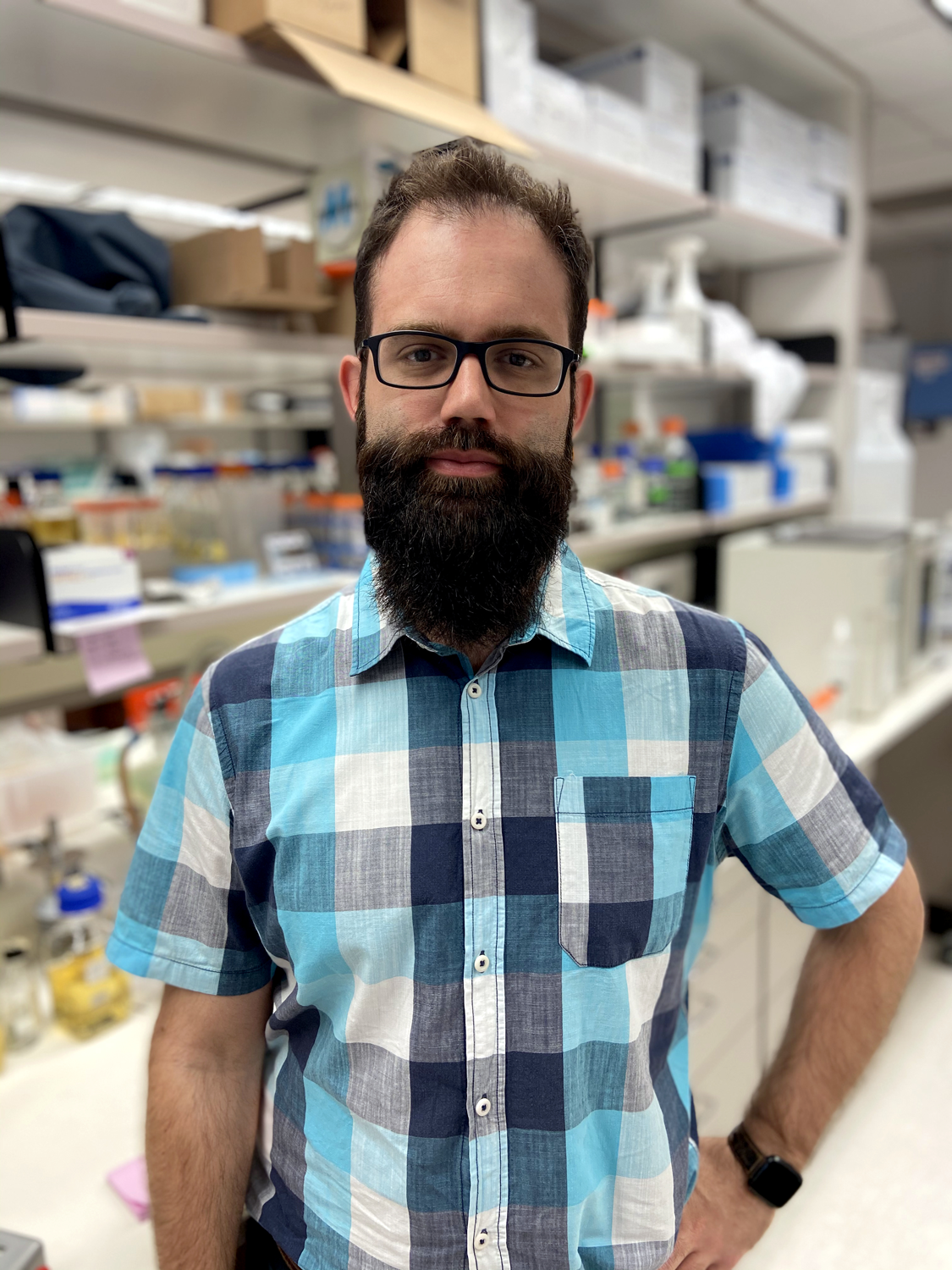Understanding how bacteria and animal interact is one of my main scientific motivations. Using Caenorhabditis elegans and a large collection of bacteria isolated from the wild I am trying to understand how microbial communities organize themselves within the nematode gut.
Publications
C. elegans related work
- Zhang, F.; Weckhorst, J. L; Assié, A; Hosea, C.; Ayoub, C. A; Khodakova, A. S; Cabrera-Loeza M.; Vidal, D.; Félix, M-A.; Samuel, B. S.; Natural genetic variation drives microbiome selection in the Caenorhabditis elegans gut, Current Biology, 2021. PMID:34048707
- Schiffer, J. A.; Stumbur, S. V.; Seyedolmohadesin, M.; Xu, Y.; Serkin, W. T. ; McGowan, N. G. ; Banjo, O.; Torkashvand, M.; Lin, A.; Hosea, C. N; Assié, A.; Samuel B. S.; O’Donnell, M. P.; Venkatachalam, V; Apfeld, J. Modulation of sensory perception by hydrogen peroxide enables Caenorhabditis elegans to find a niche that provides both food and protection from hydrogen peroxide, PLoS Pathogens, 2021. PMID:34941962
- Zhang, F.; Weckhorst, J. L; Assié, A.; Khodakova, A. S; Loeza-Cabrera, M.; Vidal, D.; Samuel, B. S. High-Throughput Assessment of Changes in the Caenorhabditis elegans Gut Microbiome, Aging, 2020. PMID: 32410031
- Dirksen, P*.; Assié, A.*; Zimmermann, J.; Zhang, F.; Tietje, A-M; Marsh, S-A.; Félix, M-A.; Shapira, M.; Kaleta, C.; Schulenburg, H. CeMbio-The
Caenorhabditis elegans microbiome resource, G3: Genes, Genomes, Genetics, 2020. PMID:32669368 - Assié, A.; Samuel B. S. The Devil Is in the Microbial Genetic Details, Molecular Cell, 2019. PMID:31226275
Collaboration work
- Wu, W-J. H; Kim, M.; Chang, L-C.; Assié, A; Saldana-Morales, F. B.; Zegarra-Ruiz, D. F.; Norwood, K.; Samuel, B. S.; Diehl, G. E. Interleukin-1B secretion induced by mucosa-associated gut commensal bacteria promotes intestinal barrier repair, Gut microbes, 2022. PMID:34989321
- Chavez, I. N; Brown, T. M; Assié, A; Bryant, A. S; Samuel, B. S.; Hallem, E. A. Skin-penetrating nematodes exhibit life-stage-specific interactions
with host-associated and environmental bacteria, BMC biology, 2021. PMID: 34620172
Deep-sea related work
- Assié, A.; Borowski, C.; van der Heijden, K.; Raggi, L.; Geier, B.; Leisch, N.; Schimak, M. P.; Dubilier, N.; Petersen, J. M. A specific and widespread association between deep‐sea Bathymodiolus mussels and a novel family of Epsilonproteobacteria, Environmental Microbiology Reports, 2016. PMID:27428292
- Assié, A.*; Leisch, N.*; Meier, D. V; Gruber-Vodicka, H.; Tegetmeyer, H. E; Meyerdierks, A.; Kleiner, M.; Hinzke, T.; Joye, S.; Saxton, M. Horizontal acquisition of a patchwork Calvin cycle by symbiotic and free-living Campylobacterota (formerly Epsilonproteobacteria), The ISME journal, 2020. PMID:31562384
Talks and Posters
- “A Microbiome in a Box: Presentation of the CeMBio project”. Oral presentation, 22nd International C. elegans Conference, 2019
- “Selecting for functions: metagenomic identification of essential functions of the microbiome in the C. elegans gut.” Oral presentation, 22nd International C. elegans Conference, 2019
- “Selecting for functions: metagenomic identification of essential functions of the microbiome in the C. elegans gut.” Invited talk, Plant Pathology department UC Berkley, 2019
- “It’s all about location! A study of bacterial ectosymbiotic communities of the deep sea shrimp Rimicaris hybisae.” Oral presentation – SilvaNGS workshop 2016
- “An alternative pathway for inorganic carbon fixation in epsilonproteobacterial epibionts of deep-sea Bathymodiolus mussels”. Oral presentation – ISME 2016
- “Diving into the genome of a deep-sea intranuclear bacteria”. Poster presentation – Young Researcher in Life Science conference 2014
- “Novel epsilonproteobacterial epibionts on the gills of deep-sea mussels from hydrothermal vents and cold seeps”. Poster presentation – FEMS 2013
- “Novel epsilonproteobacterial symbionts in gill tissues of deep-sea hydrothermal vent mussels”. Poster presentation – VAAM 2013
Awards
5th conference of the Young researcher in Life science
Best poster presentation – 3rd place – link
Education
PhD Thesis
In marine microbiology - Deep sea symbiosis
Master thesis
In marine microbiology - Deep sea symbiosis
Max Planck Institute for Marine Microbiology 2012 – 2016
Department of Symbiosis
Germany – Bremen
“Biometry and evolutive biology laboratory”
CNRS-UMR5558
France – Lyon
Decembre 2010 – June 2011
Click for more details
During my PhD thesis I studied different bacterial partners associated with deep sea invertebrate using different techniques like Fluorescent In Situ Hybridization (FISH); Next generation sequencing; Metagenomes and Metatranscriptome analysis.
My principal project focus on deep sea mussels belonging to the Bathymodiolus genus. These mussels are found worldwide at cold seeps and hydrothermal vents, they have been studied for decades for their unique association with gammaproteobacterial chemoautotroph which are settled in the host gill epithelia. Additionally to the main endosymbiont many Bathymodiolus species are associated with other low abundance bacterial phylotypes. My work was to characterize two of these secondary associated bacteria: an epibiotic epsilonproteobacteria and an intranuclear parasite.
A second part of my PhD thesis is the characterization of bacterial ectosymbiotic populations associated to a recently described deep sea shrimp Rimicaris hybisae found on the Cayman Rise. These shrimps occur at two vent site located 20km and 2500m depth apart. These two vents fields are very distinct not only in depth but also in chemical composition which is the perfect setting to have a close look at the environment influence on ectosymbiotic populations compositions.
Funded by the Marie Curie International Training Network 7 (ITN)
The main topic of the master thesis was the study of mechanisms involved in host-endosymbiont interactions between Drosophila and the Alphaproteobacteria Wolbachia.
I have maintained lines of Drosophila melanosgaster, each one expressing an interfering RNA of a host gene. Once the line were set up I analyzed the impact of the host gene inactivation on the infecting Wolbachia population by quantifying a specific bacterial single copy gene with RT-qPCR.
Master in Microbiology
Infectiology: Microbiology, Virology and Immunology - Specialty: Fundamental Microbiology
Bachelor / Licence in Biology
Speciality in microbiology
Université Paris Diderot – Paris 7
September 2010 – June 2011
Université de Montpellier 2
France · Montpellier
September 2007 – June 2010
